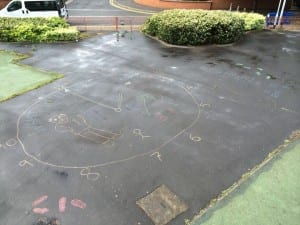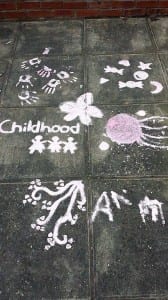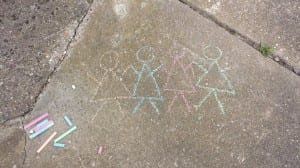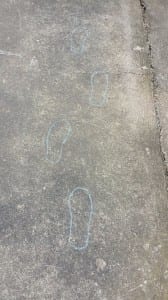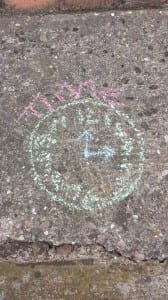Framing Statement
yOUR Journey Lincoln was a site specific performance, performed on the 7th May 2015. Our piece was a twenty minutes of an audio/visual journey which eventually leads to our final performance site where there was a 10 minuet performance. The journey itself started from the Lincoln’s performing Arts Centre, where silent guides would lead our audience through the centre of Lincoln to a deserted park under the fly-over in between Kesteven Street and Archers Street. Our journey itself was inspired by the idea of a ‘drift’, described here in ‘A starter kit for drifters’;
“It’s not a stroll in the park, but it doesn’t have to be complicated. Drifts are for opening up the world, clearing eyes and peeling away the layers of spectacle, deception and that strange “hiddenness in plain sight” that coats the everyday… so that rather than wandering ankle deep through the sediment of discarded images and illusions, you can explore the whole whirling snowglobe.” (Mythogeography, 2015)
With this is mind we set out to explore the city in a different and unique way, by not being compelled by direction. This really allowed us explore different parts of Lincoln and begin evolving our creative process. The journey we undertook from this drift is the route we decided our audience should experience. To expand on this, another type of journey that we looked was that of the theory of the ‘Imaginary Walker’. After reading the article by Coverley, it inspired me to think of journeys as not only a physical one, but as a mental construct as well. This led us to the idea of developing our journey into a more philosophically challenging experience. We resulted to the idea of exploring time by talking our audience through the subjects of ‘past, present and future’ of Lincoln’s vast cultural/economic history. A quote that resonated with me personally from Coverley is that it is “better to travel than to arrive.” (Coverley, 2012) Especially with the whole of the city being the site we were told to explore, by focusing on the journey rather than the final destination. For example the ‘drift’ it allows the audience to reconnoitre, as we did on our drift, to display a different side to Lincoln that could possibly lead the audience to notice ‘interventions’ they have never seen before. With the use of an audio/ visual guide showing the pre-recorded journey it allowed us to challenge the ideological concept of time and existence. The audio promoted the audience member to look and engage within the city in a different intimate way.
Our practical site itself, namely the park, is where we ended our drifting journey.It was at this point during the performance the audio tour stopped and audience were free to roam. When in the site the group and I continuously persisted to draw images on the floor in multi-coloured chalk. We then encouraged the audience to take part within our activity, giving them free range of the chosen space. The images we drew as a group differed from footprints, to childish images such as stick men and play ground games such as hopscotch. This linked in with the park’s original use as a play recreational space for children. We also wrote quotes from the audio such as “Lindum Colonia” (The original Roman name for Lincoln) and interesting landmarks seen on the journey, such as Lincoln’s historical Stonebow, situated in the heart of Lincoln. The mixture of images and text led to the site looking like a huge canvas reflecting on our memories and development of the journey. After we had drawn images we continuously then washed them away with water, this symbolised the futility of time perhaps how everything changes, and how things we construct all end up being destroyed or fall into decay.
Figure 1 (yOUR Journey Lincoln, 2015)
Analysis of Process
When being challenged with creating a site-specific performance many thoughts came into my mind, being as though I haven’t created a piece of performance art such as this, the idea seemed daunting. Heightened with the thought of incorporating audio into our performance, I began by doing some deeper initial research into what site-specific performance actually is and what it involves. Through reading Fiona Wilkie’s work Mapping the Terrain (2002) she highlighted variation available when working with a site other than site-specific performance. With our site situated inside Lincoln we wanted to ensure our performance was specific, over generic. This idea was something we kept in mind and monitored throughout the ensuing process.
After our ‘drift’ we found multiple and even possible sites which we could have used for our performance, we then discussed and established many thoughts of inspiration that could take place within them. One building in-particular we found of interest was that of the Lincoln Equitable Cooperative Industrial Society Limited, there are several of these building situated around Lincoln and so we thought there would be a great potential for a performance opportunity hidden within them After researching into the building’s history we found it compelling, yet unfortunately the practicalities of using this space were inadequate. Instead we looked into some of our other available choices that could be transformed into a performance site, this being the park. Our first encounter with our performance space after our ‘drift’ was inspired by the thought of what time had done to the park and the area around it; Its decay. Looking at what use to be bright colours on the slide it promoted us to think of how the park would have originally looked when first built, and more importantly the children who would have used it and maybe even the impact they had left upon the forgotten landscape. This exploration had given us the topic of time, and in particular the children of Lincoln’s past to possibly research into for our performance. Inspired by Tim Etchells’ notes on performance writing we looked into creating “a text composed of fragments” (Etchells, 1999) we thought when approaching our script to use multiple sources. Our original research brought our attention too two videos which audio we would like to use. One of an elderly lady, Margret, talking about her experiences growing up in Lincoln in Post-War Britain. Another is taken from 1935 by British Pathé, where a gentleman talks about the history of Lincoln, pointing out key features which can still be seen today, such as pointing out the Stonebow in the centre of the High Street.
As our process developed we decided to move away from the idea of children in Lincoln and moved towards exploring the subject of the past, present and future of Lincoln. Delegating these sections between the group we collectively compiled a script, which highlighted the passage of time and questioning the inevitable future of Lincoln and our within a developing city. The conceptual performance of time was inspired by Alicja Kwade piece Something Absent Whose Presence Has Been Expected (2015) who describes time as follows;
“When attempting to describe time, we have recourse to images from very different areas: time ‘flies’, ‘flows’, ‘flashes by’, ‘passes’, ‘runs out’. Equally, for measuring time there is a wide range of formal constructions available – time is sometimes organised in numbers, sometimes arranged in a circle, and sometimes divided into strips, as for example on the globe.” (Kwade, 2015)
Her piece follows the continuity and deconstruction of time. During her exhibition the spectator passes by a wall of clocks, and this translates as literally watching time pass by. Incorporating ideologies of time into our script and beginning to finalise sections, we began the long and delicate process of recording our audio. When we first started recording our audio, my group and I have previously had very little experience with the equipment on hand to us and so we had to experiment within different locations and proximities to the microphone in order to achieve the optimum sound when recording. When continuing on the process we had begun we gathered a multitude of test recordings and samples, more-or-less, of everyone saying each descriptive piece of dialogue. Using these mix-matches of recordings we decided a running order and set out recording right away. For a more refined sound we ended up using on of my group member’s professional mics. Once everything was recorded we headed over to the editing phase of the process. A lot of the group, however, were unfamiliar with how to edit audio files on audacity and so we had to accommodate to the knowledge gap.
Inspired by Blast Theory’s Can You See Me (2004) we wanted to engage our audience through the use of technology. Blast Theory does this in this show by the use of a game. The game is simple, the audience members place themselves into the virtual world (which is an exact replica of the city) and the audience would have to navigate around the space, when in real time the actor would run around outside trying to find the virtual embodiment of them. The idea of creating a synchronisation through the medium of technology is what we wanted to explore. One of the members of our group had a GoPro camera which was mounted onto a helmet. We then reordered the route taken when we went on our drift. After a few attempts slightly altering the route and the angle we finally got the video of our journey. The angle of the video taken from eye level indicates the ‘human’ aspect of the journey, one in which the audience can directly relate too. Also when challenging our audience within the audio about the difference in time they are holding an accurate depiction of the past for them to relate to. The synchronisation of both the audience’s and the groups journey is what inspired us to create our show same yOUR Journey Lincoln.
When looking at the park it easy to imagine what it once was when first built. Brand new with sparkling equipment, encouraging children to laugh and play. However time has not been kind to this place and the equipment that once was there is all but a memory, apart from the old battered slide. Within the park you can still see reminisces of what once was the play equipment, shown by the green areas on the park floor. These areas show a presence of the equipment which is now absent. Exploring the idea of the presence of something ‘absent’ I looked into the findings of Frank Ankersmit and his essay ‘Presence and representation’. In which we found these questions, “what could it possibly mean to ‘make present again’ what is ‘absent’. How can we say of something which is absent ‘that it has been made present again’? Or that something is ‘present’ in its ‘absence’?” (Ankersmit, 1992) these questions we found could to relate to our performance. Therefore we explored ideas of how we could represent the past equipment, and showing the fluidity of time. This is how we came up with the idea of turning the playground into a living piece of art by drawing on the floor of it.
This was inspired by Carlotta Brunetti’s Forét Surprise (2002) in which she painted trees within a local park in a red-ish-brown clay. The overall effects made the trees look like a painting, suggesting the simplicity of a child’s painting. This evoked the idea of nature being innocent and that “we can only experience ‘nature’ second-hand through its mediations, narratives and constructions, proposing a vulnerable to fluctuation and change.” (Rugg, 2010) this idea of drawing in a child-like manner to have a deeper meaning reflects both the normal use of the site and the dramatic use we we’re trying to convey. We henceforth experimented with lots of ideas of what to draw within the park. Firstly we explored the idea of using shadows on the floor of where the equipment use to be, we thought of using black spray paint but found that this would be been impractical to clear away after the performance was done. We therefore had to compromise, using an idea to show both this representation of the playground equipment, and a solution which would easily was off. We therefore tried out a recipe for chalk sidewalk paint consisting of corn flour and food colouring.
Figure 2 (yOUR Journey Lincoln, 2015)
Thinking, with this being a water based solution, that it would be easy to wash off. Evidently not as even now, 2 months after we first tested it, there is still a trace of it on the floor. We then had to resort to a new plan, this was using multi-coloured chalk. We found this to be a far more practical, cheaper solution, which would wash off easily was off with water.
Figure 3 (yOUR Journey Lincoln, 2015)
When using the chalk it was a lot easier to use and move around the space allowing us to have more freedom with what we could draw and the size ratio. This meant that drawings could scale from small handprints to a massive clock in the centre of the park. The chalk itself could be used as a simulacrum for time. Starting out with a fresh chalk, then as its used, progressively it gets shorter and ever shorter, sometimes snapping. This shows how easily and quickly time passes and you don’t notice until there’s hardly any left.
The main feature of our drawing was the multiple sets of footprints around the site. This again links in with the presence of something absent, ourselves. Although still within the parameters of the park we were no longer present in that precise space or time, and so there is a ‘presence’ of the past being shown. Once we had drawn an image in the park we would wash it off fully, or partly, and draw it again. The water itself represented time, and the act of washing away the past drawings and starting again shows how throughout time there is always a sense of progression, the destruction of something and its replacement. An example of this we highlighted on our journey where we paused along our route and looked at a building site happening across from the park and posed questions to the audience of what Lincoln will become.
Figure 4 (yOUR Journey Lincoln, 2015)
Performance Evaluation
On our final performance day the weather was against us. Rain meant that we had to consider our ‘wet weather plan’ making sure the video was watched before leading our audience to the site in order to protect the tablets we were using. This plan was a last resort for our intention was to have our audience watch the video, listen to the audio and go on the journey with us all at the same time. However, reluctantly another group member and I headed towards our starting point, Lincoln Performing Arts Centre, thinking we would perform our back up plan. Thankfully, just before our journey was about to start the weather lightened up, meaning that our original plan could be done. This worked in our favour because the audience could experience the full performance as intended, and they could engage fully with the audio and watch the video of our journey while in synchronisation with theirs. The practicalities of the tablets, however, still hindered our performance to an extent. The feedback we received from our audience members is that they were awkward to carry and difficult to watch due to the backlight. Another issue with technology we faced was presented to us by an audience member who struggled to hear audio at times when passing loud areas. In hindsight we should have tested the tablets more in order to make sure they were practical for the performance. Similarly we should have provided the audience members with over the head earphones in order to cut out background noise. This is something to consider if we were to put on this performance again. With having silent guides there was a little miscommunication at times when leading audience in the right direction on our journey, after a little kafuffle this was quickly rectified and soon the performance was back on track. Something we as a group worried about for our performance was the audience’s journey and our video journey synchronising. However, on the day they seemed to line up almost perfectly to our relief. Our journey took two audience members at a time due to the reliance on technical equipment, yet with posting our video on our independent performance blog (www.yourjourneylincoln.wordpress.com) audience members could have pre-watched the video and then attended our performance still with the same theoretical knowhow. This meant that every jouney is indivisual with regards to if they wacthed the video before hand or during, or just focued on the audio.the opportunity for everyone to experience a different performance also links with the idea that time effects things and people in different ways. We would have carried the performances on throughout the day, yet the weather held us back and so we only actually carried out one performance.
Personally I enjoyed the creative element we did in the park, knowing what it represented made it feel more than just an action, but a symbol. Although as a group we had disused certain ideas together about what we were doing in the site, we left partly of the performance as improvised meaning that everyone, including the audience, could use the space how they wanted without constraint. When challenging the audience members to join in and draw in the space they chose to do so briefly but then retreated and became more observers than participants; passers by as well stood and observed rather than participated. Both the situations worked with our performance, by the audience choosing to observe rather than take part they still get to acknowledge the repetitive performative actions we are doing, and by choosing to get involved they became integrated in the performance structure and part of the construction of performance we eventually destroyed.
I feel now, after working on this project that my understanding on linking theoretical ideas into a performance has become more interrogated within my theatrical work. After finding the task of creating site-specific audio work daunting and out of my comfort zone, I feel as though if I was to do this again I would be able to approach the task more confidently and creatively, knowing that performing in a non-theatrical setting hold no bound to what is available.
To conclude I wanted to highlight what an audience member, when participating in the drawings, wrote. I find the thought of this quote an interesting concept, one in which we could consider in including in our performance if we were to do this again.
“Abandon this place”
Figure 5 (yOUR Journey Lincoln, 2015)
Word Count – 3,051
Bibliography
Anna Starbuck.(2015) yOUR Journey Lincoln. [Online] Lincoln: Available from https://www.youtube.com/watch?v=rdtQSaearoY [Acsessed 09 May 2015].
Campbelltown Life Story Circles. (2013) Margaret- Lincoln UK Growing up. [Online] Lincoln: Available from https://www.youtube.com/watch?v=b43j1HkNMvY [Acsessed 08 May 2013].
Ankersmit, F. (1992) ‘Presence’ and Representation. [online] Groningen University. Available from: www.rug.nl/research/centrum-voor…/presenceandrepresentation.doc [Accessed on 8th May]
Etchells, T. (1999) Certain Fragments. Oxon; Routledge.
Coverley, M. (2012) The Art of Wandering: the writer as walker. Harpenden: Oldcastle Books.
Fiona Wilkie (2002). Mapping the Terrain: a Survey of Site-Specific Performance in Britain. New Theatre Quarterly, 18, pp 140-160.
Kwade, A. (2015) Something Absent Whose Presence Had Been Expected. [Online] Available from: http://artforum.com/uploads/guide.003/id03714/press_release.pdf [Accessed on: 6th May 2015]
Mythogeogrpahy (2015) A Starter Kit for Drifters. [Online] Available from: http://www.mythogeography.com/starter-kit.html [Accessed on 8th May 2015]
Rugg, (2010) Exploring site-specific art, issues of space and internationalism. London: I. B. Travis & Co LDT.
Figures 1 – 5 yOUR Journey Lincoln, 2015
